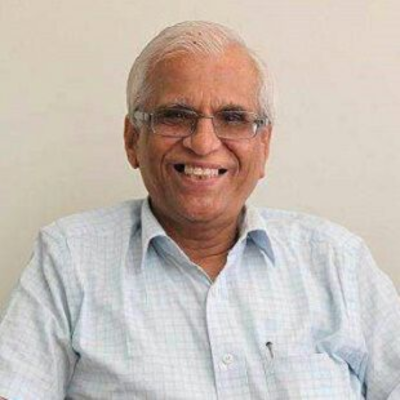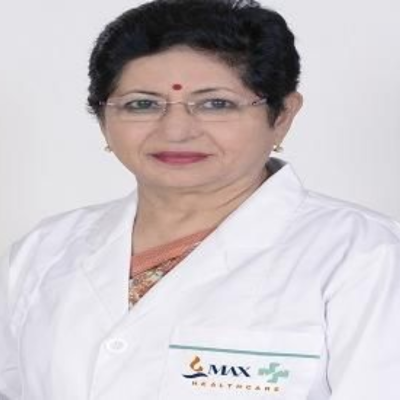The Role of Government Initiatives in Promoting Medical Tourism in India
 02 April,2025
Read More
02 April,2025
Read More
Enquire now in case of any assistance needed
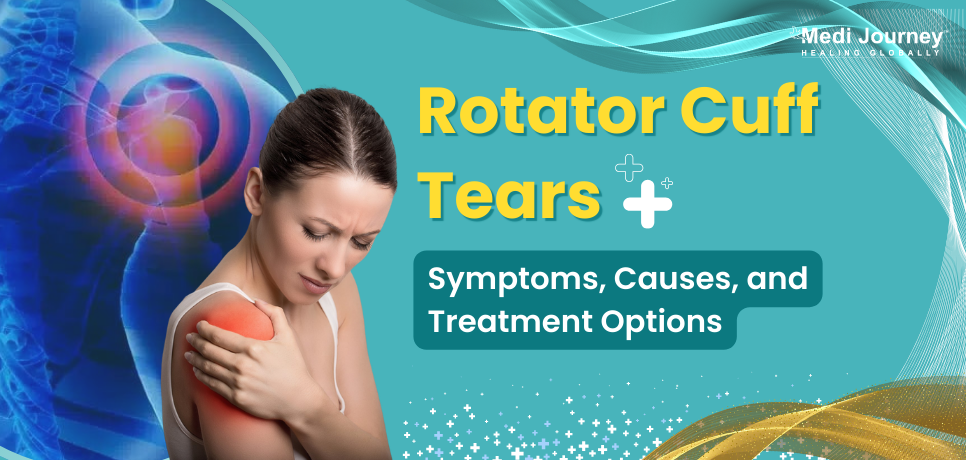
Are you a painter, athlete, weightlifter, or someone who has physically demanding hobbies like gardening? Then, you might be at a risk of having rotator cuff injuries, mostly a tear. Wondering why? The repetitive stress can irritate or tear the tendons, causing shoulder pain that can significantly limit your ability to move your arm.
The good news is that most rotator cuff injuries respond well to conservative treatment, which involves a combination of rest, ice therapy, anti-inflammatory medications, and physical therapy. However, depending on the severity of the tear, surgery might be necessary in some cases. With advancements in surgical techniques, surgery for rotator cuff tears is done arthroscopically, which is a minimally invasive approach.
Don't hesitate to visit an orthopedic hospital if you're experiencing shoulder pain, especially with overhead activities. Early intervention can help ensure a quicker and more complete recovery, keeping you in motion and doing what you love.
Read further to better understand rotator cuff tears, their symptoms, and available treatment options.
The rotator cuff isn't a single muscle but a team effort! It's a group of four muscles and their tendons that work together to provide stability and mobility to your shoulder joint. These muscles begin from your shoulder blade and wrap around the head of your humerus (upper arm bone), forming a "cuff" that holds the arm in the socket. Their coordinated action allows you to raise your arm overhead, rotate it inwards and outwards, and reach behind your back – all essential movements for everyday activities.
A rotator cuff tear is a type of shoulder injury that causes pain and instability in the arm. The two most common types of rotator cuff tears are partial and complete. The tendon doesn't completely detach from the bone in a partial rotator cuff tear. In a full-thickness or complete rotator cuff tear, the tendon gets wholly separated from the bone.
Depending on the size, rotator cuff tears can be classified as –
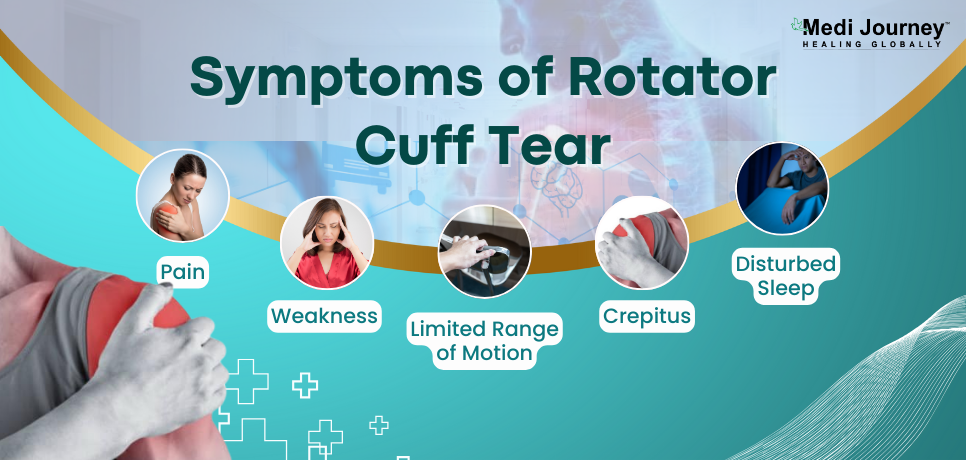
Intense pain is the first and most common sign of a rotator cuff tear. The severity of the tear can affect shoulder pain. It often starts as a dull ache, especially at night, and worsens with activities that involve raising the arm.
A limited range of motion, reduced functionality, and weakness in the shoulder are also common. Other symptoms of rotator cuff tear are-
Not every rotator cuff tear is painful. However, if you are experiencing weakness and difficulty raising your arm, especially after an injury, you must consult an orthopedic doctor immediately. Timely diagnosis and treatment are paramount for preventing further damage and ensuring a full recovery. If rotator cuff tears are left untreated, they can lead to more severe problems over time, such as a frozen shoulder or arthritis.
A rotator cuff tear is either due to acute injury or degenerative. Young people are more prone to acute injuries that mainly occur from one particular incident. Lifting heavy objects, explicitly moving the shoulder in a specific position, and falling are common causes of acute injuries.
Degenerative tears occur over a period of time due to the wearing down of the tendons. Common reasons for degenerative or chronic rotator cuff tears are –
Over 2 million Americans suffer from rotator cuff problems each year. Apart from the two primary causes, several risk factors have been linked to rotator cuff tears. These include –
Orthopedic doctors consider multiple factors when diagnosing rotator cuff tears. They will perform a thorough and detailed physical examination to assess your shoulder's range of motion, strength, and tenderness.
The final diagnosis will be made after running imaging tests such as –
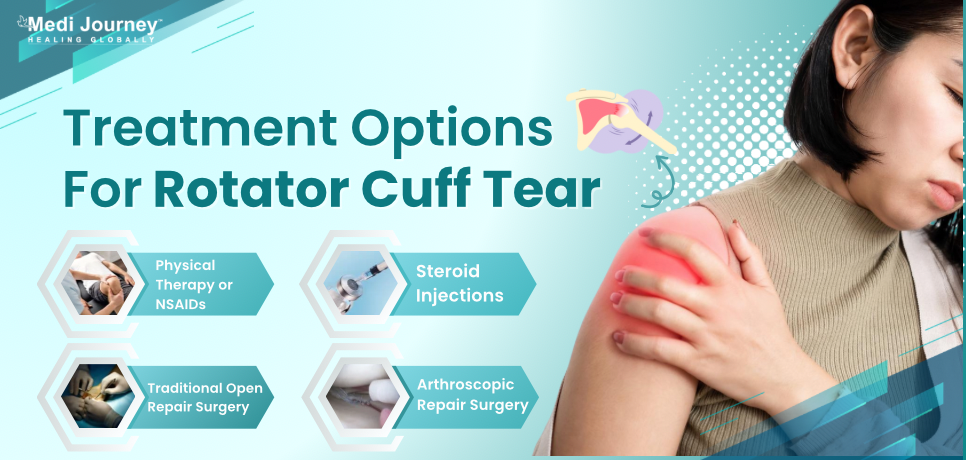
The treatment of a rotator cuff tear depends on factors such as age, type & degree of injury, general health, activity level, and extent of pain. Doctors mostly recommend nonsurgical management for rotator cuff injuries. However, surgical interventions are necessary in some instances. Various treatment methods available for rotator cuff tears are mentioned below.
Over 80% of patients experience significant improvement in pain and function of the shoulder with nonsurgical treatments. It is the first line of treatment for rotator cuff injuries and can include –
Eight out of 10 patients with partial rotator cuff tears get the desired treatment outcomes with nonsurgical methods. However, this treatment method has a few disadvantages, such as a limit to specific activities and the possibility that the tear size will increase with time.
Note: Rotator cuff tears do not heal on their own.
Not every patient with rotator cuff injuries or tears requires surgery. The doctor recommends surgical interventions for patients who have –
The most common surgeries done for rotator cuff tear are –
Don't let shoulder pain sideline you from the activities you love! Knowing the signs of a rotator cuff tear empowers you to take charge of your shoulder health. Contact a skilled orthopedic doctor for a proper diagnosis if you're experiencing shoulder pain, especially with overhead activities. Early intervention through non-surgical treatments like physical therapy can significantly improve your condition and get you back to moving freely.
Doctor of Pharmacy
Dr. Deepanshu Siwach is a skilled clinical pharmacist with a Doctor of Pharmacy degree.?He has 4+?years of experience and has worked with thousands of patients. He has been associated with some of the top hospitals, such as Artemis Gurgaon.
Director
Orthopedic and Joint Replacement Surgeon
Aakash Healthcare Super Speciality Hospital, Dwarka, New Delhi
Dr. Aashish Chaudhry is amongst the best Orthopedic Surgeons, with over 23 years of experience....
Senior Consultant
Medical Oncologist
Nanavati-Max Super Speciality Hospital, Mumbai
Book Appointment WhatsApp UsSenior Director
Gynecologist and Obstetrician, IVF Specialist
Max Super Speciality Hospital, Shalimar Bagh, New Delhi
Book Appointment WhatsApp UsSenior Director
Gynecologist and Obstetrician, IVF Specialist
Max Smart Super Speciality Hospital, Saket, New Delhi
Book Appointment WhatsApp UsSenior Director
Gynecologist and Obstetrician
Max Smart Super Speciality Hospital, Saket, New Delhi
Book Appointment WhatsApp UsSenior Director
Gynecologist and Obstetrician
Max Smart Super Speciality Hospital, Saket, New Delhi
Book Appointment WhatsApp UsSenior Director
Gynecologist and Obstetrician
Max Smart Super Speciality Hospital, Saket, New Delhi
Book Appointment WhatsApp UsFill up the form and get assured assitance within 24 hrs!
The Art of Effective Communication
 24 January,2025
Read More
24 January,2025
Read More
Trusted by Patients
"I am Asim from Bangladesh and was looking for treatment in India for neuro. I visited many websites to get the complete information regarding the treatment but I was not satisfied as I was getting confused. In the meanwhile, one of my friends suggested I seek help from Medi Journey as he experienced his medical journey very smoothly and was satisfied with it. They have filtered the top 10 doctors as per experience, the success rate of surgery & profile, so it helps us to choose the best treatment in India. "
"For my knee surgery, Medi Journey guided me to BLK Hospital where I received exceptional care. The team's support and the expertise at BLK Hospital exceeded my expectations. Thank you Medi Journey for making my medical journey stress-free. "
"I came from Iraq for my granddaughter's eye surgery in India facilitated by Medi Journey, due to critical cases they advised us to get a second opinion from the different hospitals before going to surgery. Finally, we went to Fortis Escort Hospital, which helped us to get more confidence for diagnosis. Fortis Escort Hospital has the best eye surgeon team with the latest instruments. Thanks to all team members for providing a high-quality treatment in India at an affordable cost. "
"I came for my hair transplant in India, before coming I was so confused about choosing the best clinic and surgeon for me. But thanks to God one of my friends had a hair transplant in India through Medi Journey. He recommended me to go with them. I am completely happy with my experience with them. They were always very fast in their responses to me. the success rate of my hair transplant surgery is 100%."
"Artemis Hospital, suggested by Medi Journey, turned out to be a great choice for my treatment. The personalized assistance and medical care were exceptional. I'm grateful to Medi Journey for guiding me to a hospital that perfectly matched my needs. Highly recommended! "
"I came from Afghanistan for my treatment in India at Jaypee Hospital, Noida. I had a fantastic experience with Medi Journey. Kudos to them for their incredible support during my medical journey. They not only took care of all the logistics but also connected me with a fantastic healthcare team. Efficient, caring, and highly recommended for a hassle-free medical tourism experience."
"I am Adam from Kano, Nigeria, one of my friends from Nigeria was facilitated by Medi Journey, and he recommended us to go with them. I sent my all reports to them and within 48 hours they reverted with 4 options from different hospitals. They helped me to get a Visa letter from the hospital, arrange pick-up from the airport, and book a hotel for me. Their team is very honest and throughout our stay in India they are with us they are caring for us like his family members. BLK Hospital is the best hospital in India with a top surgical oncologist surgeon team, a very advanced OT, and a Radiotherapy department. I wish more success to Medi Journey. "
"Great experience at the Max Hospital for my spine surgery and was successfully done. I thank my neurosurgeon and his entire team. I recommended all of my country's people to Medi Journey for treatment in India, they choose the best hospital, the best doctors, and the best cost for patients."
"I came to India from Dhaka, Bangladesh for my father-in-law's cardiac surgery at Fortis Hospital. I was confused about choosing the best surgeon for him before coming, but their team helped me to choose the best hospital and best cardiac surgeon in India with very good cost and 100% success rate of surgery. I am very happy with the services, really they make my journey so comfortable that make me feel at home. Thanks again and I like people to choose "Medi Journey" as your travel guide. "
"I am Mohammad from Bangladesh came to India for my general health checkup. Medi Journey offers me the complete package including Pick-up from the airport, hotel services, and 24-hour assistance. They guide you to choose the best hospital in India, the best cost of treatment with top-most doctors and give you complete information about hotel booking, and pick-up from the airport before coming to India They have the best team to help. Always choose Medi Journey for your treatment in India."
